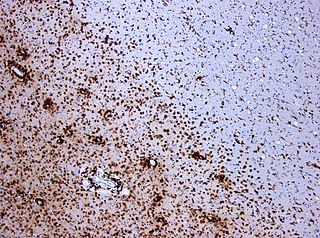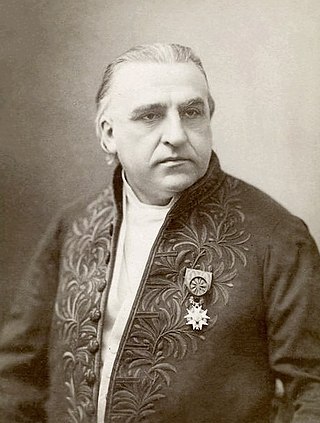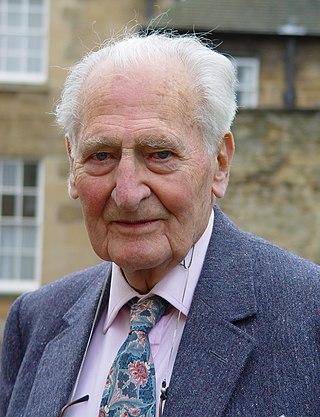Related Research Articles

Franz Kafka was a German-speaking Bohemian Jewish novelist and writer from Prague. He is widely regarded as one of the major figures of 20th-century literature. His work fuses elements of realism and the fantastic. It typically features isolated protagonists facing bizarre or surrealistic predicaments and incomprehensible socio-bureaucratic powers. It has been interpreted as exploring themes of alienation, existential anxiety, guilt, and absurdity. His best known works include the novella The Metamorphosis and novels The Trial and The Castle. The term Kafkaesque has entered English to describe absurd situations like those depicted in his writing.

Multiple sclerosis (MS) is an autoimmune disease in which the insulating covers of nerve cells in the brain and spinal cord are damaged. This damage disrupts the ability of parts of the nervous system to transmit signals, resulting in a range of signs and symptoms, including physical, mental, and sometimes psychiatric problems. Specific symptoms can include double vision, vision loss, eye pain, muscle weakness, and loss of sensation or coordination. MS takes several forms, with new symptoms either occurring in isolated attacks or building up over time. In the relapsing forms of MS, between attacks, symptoms may disappear completely, although some permanent neurological problems often remain, especially as the disease advances. In the progressive forms of MS, bodily function slowly deteriorates and disability worsens once symptoms manifest and will steadily continue to do so if the disease is left untreated.

Trigeminal neuralgia, also called Fothergill disease, tic douloureux, trifacial neuralgia, or suicide disease, is a long-term pain disorder that affects the trigeminal nerve, the nerve responsible for sensation in the face and motor functions such as biting and chewing. It is a form of neuropathic pain. There are two main types: typical and atypical trigeminal neuralgia. The typical form results in episodes of severe, sudden, shock-like pain in one side of the face that lasts for seconds to a few minutes. Groups of these episodes can occur over a few hours. The atypical form results in a constant burning pain that is less severe. Episodes may be triggered by any touch to the face. Both forms may occur in the same person. It is regarded as one of the most painful disorders known to medicine, and often results in depression and suicide.

Apathy is a lack of feeling, emotion, interest, or concern about something. It is a state of indifference, or the suppression of emotions such as concern, excitement, motivation, or passion. An apathetic individual has an absence of interest in or concern about emotional, social, spiritual, philosophical, virtual, or physical life and the world. Apathy can also be defined as a person's lack of goal orientation. Apathy falls in the less extreme spectrum of diminished motivation, with abulia in the middle and akinetic mutism being more extreme than both apathy and abulia.
In academic publishing, a retraction is a mechanism by which a published paper in an academic journal is flagged for being seriously flawed to the extent that their results and conclusions can no longer be relied upon. Retracted articles are not removed from the published literature but marked as retracted. In some cases it may be necessary to remove an article from publication, such as when the article is clearly defamatory, violates personal privacy, is the subject of a court order, or might pose a serious health risk to the general public.

David Baldacci is an American novelist. An attorney by education, Baldacci writes mainly suspense novels and legal thrillers.

Jean-Martin Charcot was a French neurologist and professor of anatomical pathology. He worked on groundbreaking work about hypnosis and hysteria, in particular with his hysteria patient Louise Augustine Gleizes. Charcot is known as "the founder of modern neurology", and his name has been associated with at least 15 medical eponyms, including various conditions sometimes referred to as Charcot diseases.

Hermann Broch was an Austrian writer, best known for two major works of modernist fiction: The Sleepwalkers and The Death of Virgil.

Sir William Richard Shaboe Doll was a British physician who became an epidemiologist in the mid-20th century and made important contributions to that discipline. He was a pioneer in research linking smoking to health problems. With Ernst Wynder, Bradford Hill and Evarts Graham, he was credited with being the first to prove that smoking increased the risk of lung cancer and heart disease.
Pseudobulbar affect (PBA), or emotional incontinence, is a type of neurological disorder characterized by uncontrollable episodes of crying or laughing. PBA occurs secondary to a neurologic disorder or brain injury. Patients may find themselves crying uncontrollably at something that is only slightly sad, being unable to stop themselves for several minutes. Episodes may also be mood-incongruent: a patient may laugh uncontrollably when angry or frustrated, for example. Sometimes, the episodes may switch between emotional states, resulting in the patient crying uncontrollably before dissolving into fits of laughter.
David Lawrence Sackett was an American-Canadian physician and a pioneer in evidence-based medicine. He is known as one of the fathers of Evidence-Based Medicine. He founded the first department of clinical epidemiology in Canada at McMaster University, and the Oxford Centre for Evidence-Based Medicine. He is well known for his textbooks Clinical Epidemiology and Evidence-Based Medicine.
Nicholas Royle is an English novelist, editor, publisher, literary reviewer and creative writing lecturer.
Inflammatory demyelinating diseases (IDDs), sometimes called Idiopathic (IIDDs) due to the unknown etiology of some of them, are a heterogenous group of demyelinating diseases - conditions that cause damage to myelin, the protective sheath of nerve fibers - that occur against the background of an acute or chronic inflammatory process. IDDs share characteristics with and are often grouped together under Multiple Sclerosis. They are sometimes considered different diseases from Multiple Sclerosis, but considered by others to form a spectrum differing only in terms of chronicity, severity, and clinical course.
Research in multiple sclerosis may find new pathways to interact with the disease, improve function, curtail attacks, or limit the progression of the underlying disease. Many treatments already in clinical trials involve drugs that are used in other diseases or medications that have not been designed specifically for multiple sclerosis. There are also trials involving the combination of drugs that are already in use for multiple sclerosis. Finally, there are also many basic investigations that try to understand better the disease and in the future may help to find new treatments.

Dr Ernst Weiss was a German-speaking Austrian physician and author of Jewish descent. He is the author of Ich, der Augenzeuge, a novel dealing with the Hitler period.
James Walker Dawson was a Scottish pathologist remembered for his work on multiple sclerosis including the description of the eponymous Dawson's fingers.
The Journal of a Disappointed Man is the first volume of published journal entries by English naturalist and diarist Bruce Frederick Cummings, writing under the pen name W. N. P. Barbellion.
Graphic medicine connotes the use of comics in medical education and patient care.
There are several ways for pharmaceuticals for treating multiple sclerosis (MS) to reach the market.
George Jelinek is an Australian doctor who is professor and founder, Neuroepidemiology Unit, Melbourne School of Population and Global Health. This unit expressly evaluates modifiable risk factors that predict the progression of Multiple sclerosis. He has served since 2017 as the Chief Editor for Neuroepidemiology in the journal Frontiers in Neurology, and he was Founding Editor – and is currently the Editor Emeritus – for Emergency Medicine Australasia. Jelinek also has the distinction of being the first Professor of Emergency Medicine in Australasia. Between 1987 and 2018, he published more than 150 peer-reviewed papers, seven book forewords and eight books, and received more than 20 research grants. He is a frequent invited speaker.
References
- 1 2 "Award-winning novelist David Wheldon dies, aged 70". The Bookseller. Retrieved 2022-06-21.
- ↑ Lockwood, David (March 2021). "Signs of Kafka in David Wheldon's Novels". ResearchGate. doi:10.13140/RG.2.2.26399.84645.
- ↑ Januszczak, Waldemar (1984-04-03). "Meridian, David Wheldon's Course of Instruction". BBC Sounds. BBC Sounds.
- ↑ Jordan, Elaine (1983-04-21). "Travelling". London Review of Books. Vol. 05, no. 7. ISSN 0260-9592 . Retrieved 2022-06-29.
- ↑ "Kafka and Dickens: the unconscious made public". www.davidwheldon.co.uk. Retrieved 2022-06-21.
- ↑ "David Wheldon Books". 2022-06-29.
- ↑ Longlands, absolutearts com, Sarah. "Sarah Longlands, Footsteps In The Snow". absolutearts.com / wwar.com. Retrieved 2022-06-21.
{{cite web}}: CS1 maint: multiple names: authors list (link) - ↑ O'Reilly, Aiden (April 2017). "RE:fresh David Wheldon". The Stinging Fly. 2 (36). ISBN 9781906539627.
- ↑ "Confingo Publishing". CŌNFINGŌ PUBLISHING. Archived from the original on 2022-06-21. Retrieved 2022-06-21.
- ↑ Wheldon, David (2022-06-21). "David Wheldon poet, novelist, pathologist". Archived from the original on 2022-06-21. Retrieved 2022-06-21.
- 1 2 "Seeking a cure for Multiple Sclerosis" (PDF). Sidcotian Friends (Autumn, Winter 2015): 12, 13. 2015-11-01.
- ↑ Wheldon, David B.; Stratton, Charles W. (2006-11-01). "Multiple sclerosis: an infectious syndrome involving Chlamydophila pneumoniae". Trends in Microbiology. 14 (11): 474–479. doi:10.1016/j.tim.2006.09.002. PMID 16996738.
- ↑ Wheldon, David B.; Stratton, Charles W. (2007-10-01). "Antimicrobial treatment of multiple sclerosis". Infection. 35 (5): 383–385. doi:10.1007/s15010-007-7036-5. PMID 17882356. S2CID 39176800.
- ↑ Ntatsaki, Eleana; Watts, Richard A. (2010-02-04). "Management of polymyalgia rheumatica". BMJ. 340: c620. doi:10.1136/bmj.c620. ISSN 0959-8138. PMID 20133367. S2CID 9343105.
- ↑ "Wheldon Protocol | Cpnhelp.org". cpnhelp.org. Retrieved 2022-06-29.